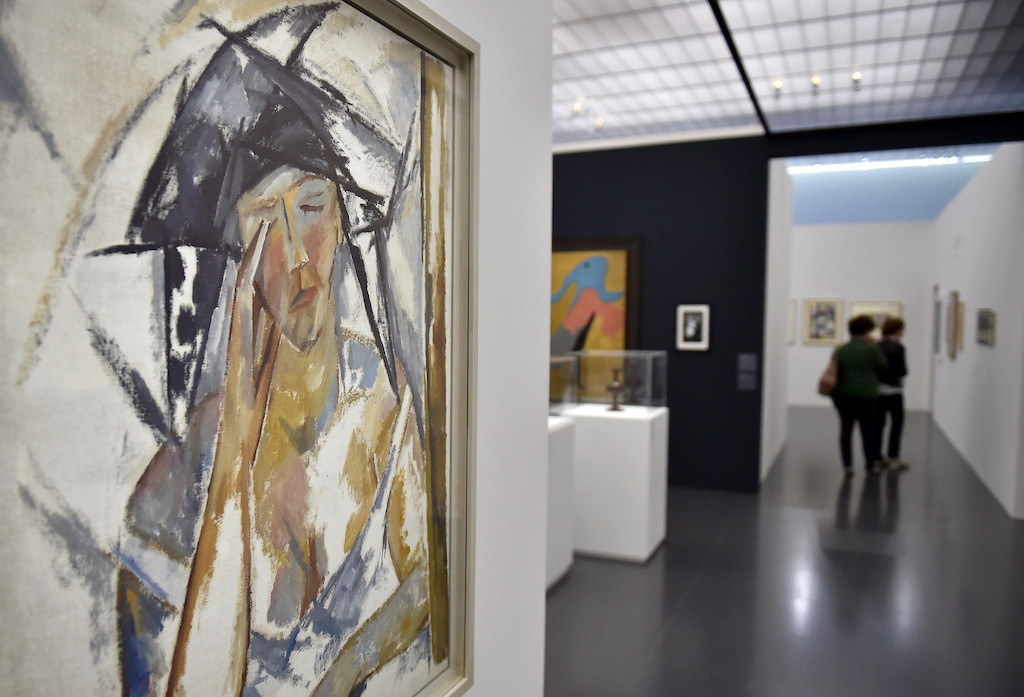Popular Reads
Top Results
Can't find what you're looking for?
View all search resultsPopular Reads
Top Results
Can't find what you're looking for?
View all search resultsDora Maar shakes off Picasso's shadow in new Paris show
Change text size
Gift Premium Articles
to Anyone
 Visitor stand in background of pieces of art by the couple of artists Natalia Gontcharova and Mikhaïl Larionov during the exhibition 'Couples modernes' on May 4, 2018 at the Centre Pompidou-Metz museum in Metz, eastern France. Pablo Picasso and Dora Maar, the Delaunay's, Georgia O'Keeffe and Alfred Stieglitz, Man Ray and Lee Miller, the Eames's are some of the around forty artist couples showcased in this important cross-topical exhibition organized by Centre Pompidou-Metz in collaboration with Barbican Centre, London. (AFP/Jean-Christophe Verhaegen)
Visitor stand in background of pieces of art by the couple of artists Natalia Gontcharova and Mikhaïl Larionov during the exhibition 'Couples modernes' on May 4, 2018 at the Centre Pompidou-Metz museum in Metz, eastern France. Pablo Picasso and Dora Maar, the Delaunay's, Georgia O'Keeffe and Alfred Stieglitz, Man Ray and Lee Miller, the Eames's are some of the around forty artist couples showcased in this important cross-topical exhibition organized by Centre Pompidou-Metz in collaboration with Barbican Centre, London. (AFP/Jean-Christophe Verhaegen)
S
he has gone down in his history as the muse who was almost Picasso's match, but a new show in Paris tries to drag Dora Maar out from under his shadow.
The huge retrospective at the Pompidou Centre -- which will transfer to London's Tate Modern in November -- portrays Maar as a leading surrealist who had a sparkling career in her own right before she met Picasso.
Indeed, it was she who first took him as a model when she got Picasso to pose before her camera in her Paris studio in 1935.
Picasso was going through what he called "the most difficult period of (his) life" at the time, having not painted for several months.
Their tumultuous nine-year affair, conducted almost entirely in Spanish, began in 1936 and helped rekindle his creative spark.
From the start "they began painting each other", said Damarice Amao, one of the curators of the show, with Picasso urging her to swap her camera for a paintbrush.
"Inside every photographer is a painter trying to get out," he declared dismissively.
The pair collaborated on his masterpiece "Guernica", with Dora photographing the black and white anti-war work at every stage of its development and Picasso using her images to develop the enormous canvass.
"The Weeping Woman" portraits of her also came out of their work on "Guernica", but they would later come to define the way the macho Spanish artist used and abused her, playing her off against his partner Marie-Therese Walter, whom he never left.
'Muse' no more
Yet from 1936 onwards Maar became Picasso's most important model and muse, with some 60 works based around her.
The Pompidou show, however, is at pains to avoid the "m" words.
Instead it wants to "bring her profound talent to the fore... so it can prevail over the more popular vision of Dora Maar as muse and model," labels which Amao argued "limit our view of her to her relationship with Picasso".
And it is the defiantly independent Dora -- who was born in France and grew up in Buenos Aires -- and who was already a name on the Paris art scene before she met Picasso, that emerges from the exhibition.
Maar had her own successful photographic studio working with top fashion houses like Chanel, Lanvin and Schiaparelli and was at the heart of the Surrealist movement.
Along with Man Ray, she was one of only a handful of photographers to be admitted into the movement's shows, said curator Karolina Ziebinksa-Lewandowska.
She was "the incarnation of the modern woman", she added, even appearing as such in some surrealist collages works alongside jazz bands and Bugatti sports cars.
Her highly-polished work, "her childhood spent in Argentina and her Slavic (Croat) origins created a remarkable personality that was completed by her acute sense of style."
Remarkable street photos
But the glitz and glamour was only a part of her "complex creative self", said Ziebinksa-Lewandowska.
As the world sank into the Great Depression, she became active in leftwing politics and began shooting the poor in the streets of Paris, London and Barcelona, creating a trove of remarkable images to match those of her friends and contemporaries Brassai and Henri Cartier-Bresson.
Such was her renown that she was the model for an enigmatic lesbian photographer who took arty erotic portraits in the classic 1947 French film, "Quai des Orfevres".
The character even wore a jumper embroidered with her name, "Dora".
Yet at Picasso's urging she turned her back on photography for painting, and was hospitalised for a short period for depression during their prolonged and messy break-up.
Read also: Stolen Picasso unearthed by 'Indiana Jones of art'
'She wasn't mad'
It was the beginning of what would become her "45 years of solitude", where she gradually withdrew from the world to live in the south of France.
Ziebinksa-Lewandowska said Maar never stopped working or developing as a artist, even as she retreated into Catholic mysticism and meditation, sketching even during Mass.
But she admitted that she could be "rather awful" to anyone who dared disturb her.
"Even when she was young she was sometimes seen as haughty and as life went on that may have become more pronounced. She could be rather horrible but she wasn't mad," Ziebinksa-Lewandowska said.
The Pompidou show is also about restoring the legacy of her later work, said her co-curator Amao.
"Like many female artists of that generation she did not create her own narrative," she said, and so Dora Maar was swallowed up in the grand Picasso myth.










